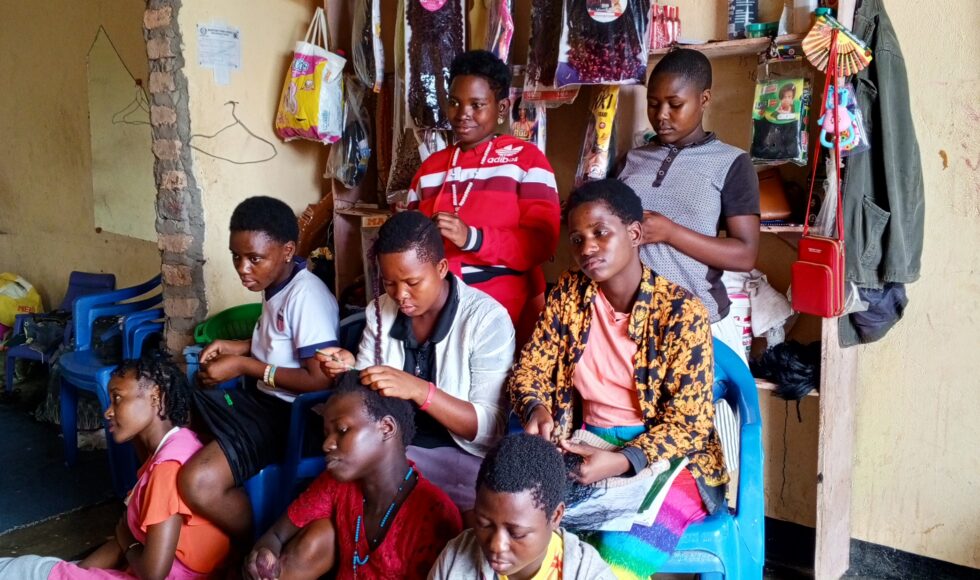Outcome: Improved income generation for vulnerable children and youth in Kitagwenda County
The Apprenticeship Programme is a job skills training process. During an apprenticeship, we put youth in structured, short-term placements to learn specific trades along an agricultural value chain with supervision and coaching by master artisans. The Apprenticeship Programme is one of COSIL’s strategies to improve the socio-economic skills of youth from vulnerable households. When youth are taught how to start their own business or learn skills necessary for gainful employment, household income increases and the socio-economic status of households improves.
There are two different kinds of apprenticeship: Informal and Formal
- Formal Apprenticeship: Youth learn skills while working in small enterprises, learning alongside a craft person. On the job learning is supplemented with classroom instruction.
- Informal Apprenticeship: Youth learn skills while working in small enterprises, learning alongside a craftsperson
The COSIL Apprenticeship model is a hybrid model borrowing from both the formal and informal model. It involves placement of youth identified from vulnerable households, with local artisans. The apprentice works with the master artisans and learns the respective trade on the job along a agricultural value chain. The master artisans, who are more experienced or knowledgeable, help to mentor the less experienced trainees in the selected trade, guided by a structured curriculum. Our Apprenticeship model is more cost effective and practical than sending youth to for formal vocational institutes. The formal vocational institutes, which exist for similar training, are often located far from the youth and require expensive attendance fees. Placing youth with artisans near their households reduces cost and time spent in transit. It also helps to mitigate household vulnerability since the youth still live at home and can support their families with household responsibilities and other activities.
Main objectives of the COSIL Apprenticeship Programme
- Reduce youth unemployment in the project area and Uganda in general.
- Increase access to skills development programmes for youth along agricultural value chain.
- Increase income for vulnerable households.
Implementation
To effectively implement a structured and successful Apprenticeship Programme for the Youth selected from vulnerable households, a three-phased critical pathway is followed.
Critical Pathway
1. Pre-placement
2. Placement
3. Post-placement
Pre placement
- Identification of youth from the NAT and the VAT
- Selection of youths satisfying the criteria
- Identification of trainers
- Trainer orientation
- Career guidance to the youths
- Orientation in order to manage the expectation of:
- Youths
- Care givers
- Matching youth to trainer and signing MOU
Placement
- Placement of youth
- Monthly assessment and
- Monitoring youth by the program officer
- Appraisal form
- Monthly questionnaire
- Other Training:
- Life skills trainingFinancial literacyBusiness skills
- Village Savings Loans Association (VSLA)
Post placement
- Graduation
- Post-graduation opportunity
- identification (Exit questionnaire)
- On-going support after graduation
- Tracer questionnaire
Verification of pre-selected youth
Verification is done using the selection criteria below:
- Youth must be between 14-30 years old.
- Youth must be permanent residents in the area of operation.
- Youth/Households should be willing to contribute to the programme. For example, they could contribute transportation, lunch or basic training materials.
- Youth must be out of school at the time of the programme to prevent dropping out of school to join the programme.
Identification and selection of trainers/artisans
Once we identify viable trades, the next step is selecting the most appropriate artisans for collaboration. The master artisans identified will then be subjected to a verification exercise using the following selection criteria:
- Artisans have no history of child abuse.
- Artisans are exposed to basic child protection skills and information.
- Artisans are engaged in the selected marketable trade.
- Artisans have sufficient work places and basic tools. Gap analysis will be done for each artisan in terms of the equipment available and needed for the training. The option of purchasing training equipment for the artisan instead of paying them a training fee should also be considered.
- Artisans’ businesses are near to the selected beneficiaries.
- Artisans are available and willing to take on trainees.
- Artisan demonstrable ability to mentor youth.
- Artisans are not related to any COSIL staff. In case this is the case, a declaration must be designed and another COSIL staff member verifies if there is potential for conflict of interest.
- Artisans are able to train youth in the basics skills listed in the training curriculum
- Artisans have past experience working with youth.
- Artisans have a strong reputation in the community.
Before the training begins, staff and artisans need to counsel youth about what skills they will acquire. This helps the youth understand what they will be learning, make informed decisions and prepare for the training. The counseling takes place in focus group discussions, and is guided by the following questions:
- What trades are the youth interested in?
- Why are they interested in those particular trades?
- What are the marketable trades available in the community?
- Why is COSIL encouraging the youth to be enrolled in only marketable trades along the agricultural value chain?
- What can the project do to ensure there is no gender stereotyping during selection?
Youth & caregivers orientation
The training begins with an orientation. Orientation will likely be the first time apprentices will hear about the COSIL programme in detail and have the opportunity to ask questions.
Orientation is crucial to managing the expectations of the youth before placement.
During orientation, the following key themes will be discussed:
- What is apprenticeship?
- What is the COSIL apprenticeship model?
- What are the expectations of the youth and the care givers?
- What does the project expect from the youth and from the care givers?
- What additional support and trainings will be provided during and after the training to enhance youth’s chances to successfully start and operate businesses or get gainful employment?
Facilitator’s must be able to clearly articulate COSIL’s objectives and programming during the Orientation
What sort of support will be provided to the youth by the project?
COSIL will pay training fees to artisans; provide training curriculum, Certificate of Graduation, some basic training and startup toolkits. Trainees will be encouraged to save for their own starter kits through the VSLAs. When this is not feasible, COSIL will provide start up toolkits on a cost share basis for groups. This will be done on a case-by-case basis after identifying the capacity of the youth and respective household to provide for the toolkits. Another option is to give the toolkits on a loan basis, payable over an agreed upon time frame.
• What contribution is expected from the youth and their households?
Transport, lunch and some basic training materials
• What does the project expect from the youth?
Interest and commitment to learn, time keeping, regular attendance and good behavior
• Beyond supporting their placement to acquire technical skills, what other training is COSIL going to provide to the youth?
Life skills, VSLA, business skills and financial literacy trainings
- Training Period
The training period ranges from 3 to 12 months. It cannot go beyond 12 months. Each trade determines its own ideal training period.

